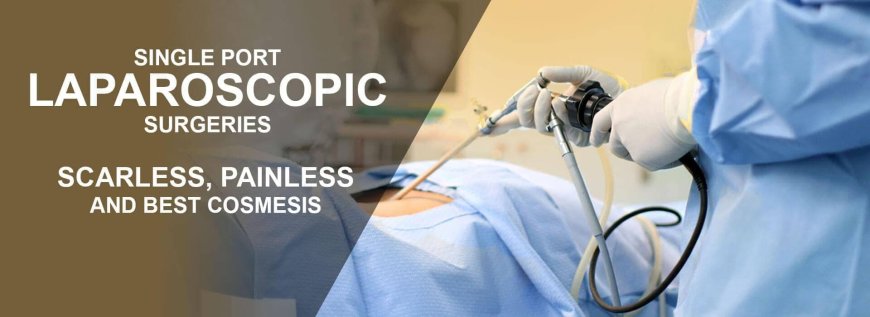Laparoscopic Surgery: Purpose, Procedure, and Benefits
Laparoscopic surgery involves using a laparoscope, a thin, flexible tube with a high-resolution camera and light at the tip. The surgeon makes small incisions, inserts the laparoscope, and views the inside of the body on a monitor in real time. Specialized instruments are used to perform the surgery through these small openings.

Laparoscopic surgery, also known as minimally invasive surgery or keyhole surgery, has revolutionized the medical field. It is a modern surgical technique that allows doctors to perform procedures through small incisions, using advanced tools and a camera to guide them. This method is highly effective, less invasive, and offers faster recovery compared to traditional open surgeries. In this article, we will explore the purpose, procedure, and benefits of laparoscopic surgery.
What is Laparoscopic Surgery?
Laparoscopic surgery involves using a laparoscope, a thin, flexible tube with a high-resolution camera and light at the tip. The surgeon makes small incisions, inserts the laparoscope, and views the inside of the body on a monitor in real time. Specialized instruments are used to perform the surgery through these small openings.
This technique is commonly used for abdominal and pelvic surgeries but has expanded to include various other medical fields, such as thoracic and orthopedic surgeries.
Purpose of Laparoscopic Surgery
Laparoscopic surgery is performed for diagnostic and therapeutic purposes. Some common uses include:
1. Diagnosis
- Investigating the cause of unexplained abdominal or pelvic pain.
- Detecting conditions such as endometriosis, adhesions, or tumors.
- Diagnosing infertility issues or evaluating reproductive organs.
2. Treatment
- Gallbladder Removal (Cholecystectomy): Treating gallstones or inflammation.
- Hernia Repair: Fixing weakened abdominal walls.
- Appendectomy: Removing an inflamed appendix.
- Bariatric Surgery: Assisting with weight loss by reducing stomach size.
- Hysterectomy: Removing the uterus or other reproductive organs.
- Cancer Treatment: Removing tumors or lymph nodes.
Laparoscopy is also used in urology, gastroenterology, and cardiology for specialized surgeries.
The Laparoscopic Surgery Procedure
1. Preparation
- Consultation: The doctor reviews your medical history, conducts tests, and explains the procedure.
- Fasting: Patients are typically advised to fast for several hours before the surgery.
- Medication Adjustments: Certain medications may need to be paused or adjusted prior to the procedure.
2. During the Surgery
- Anesthesia: General anesthesia is administered to ensure the patient is unconscious and pain-free.
- Incisions: Small incisions, usually 0.5–1 cm long, are made in the skin.
- Inserting the Laparoscope: The laparoscope and surgical instruments are inserted through these incisions.
- Inflating the Abdomen: Carbon dioxide gas is used to inflate the abdomen, providing a clear view and space to operate.
- Performing the Surgery: The surgeon operates using the tools while monitoring the progress on a video screen.
3. Post-Surgery
- The instruments are removed, the gas is released, and the incisions are closed with sutures or surgical glue.
The entire process typically takes 30 minutes to a few hours, depending on the complexity of the procedure.
Benefits of Laparoscopic Surgery
Laparoscopic surgery offers numerous advantages over traditional open surgery:
1. Minimal Invasiveness
- Requires smaller incisions, reducing the risk of infection and scarring.
2. Faster Recovery Time
- Patients can return to daily activities much sooner than with open surgery.
3. Reduced Pain and Discomfort
- Smaller incisions mean less postoperative pain and fewer painkillers required.
4. Shorter Hospital Stays
- Many procedures are performed as outpatient surgeries, allowing patients to go home the same day.
5. Lower Risk of Complications
- Reduced exposure of internal organs minimizes the risk of infection and complications.
6. Better Precision
- High-resolution cameras provide clear visuals, enabling surgeons to operate with greater accuracy.
Risks and Limitations
While laparoscopic surgery is generally safe, there are potential risks:
- Infection or Bleeding: Though rare, any surgery carries these risks.
- Organ Damage: Accidental injury to nearby organs during the procedure.
- Anesthesia Reactions: Possible adverse effects from general anesthesia.
- Conversion to Open Surgery: In some cases, a laparoscopic procedure may need to be converted to open surgery due to complications.
It’s essential to discuss these risks with your doctor and ensure the procedure is appropriate for your condition.
Who is a Candidate for Laparoscopic Surgery?
Laparoscopic surgery is suitable for most patients but may not be ideal in cases of:
- Severe obesity.
- Extensive scar tissue from previous surgeries.
- Severe organ damage or advanced-stage disease.
A thorough evaluation by your surgeon will determine if laparoscopic surgery is the best option for you.
Recovery After Laparoscopic Surgery
- Post-Surgical Care: Patients are advised to rest for a day or two and avoid strenuous activities for a few weeks.
- Pain Management: Over-the-counter pain relief or prescribed medications may be used.
- Follow-Up Visits: Regular check-ups ensure proper healing and address any concerns.
Patients are often able to return to work and normal activities within 1–2 weeks, depending on the type of surgery performed.
Conclusion
Laparoscopic surgery is a groundbreaking technique that has transformed the surgical landscape. It offers patients a safer, faster, and less painful alternative to traditional open surgery. With its minimal invasiveness and quicker recovery times, it continues to be the preferred choice for many procedures.
If you’re considering laparoscopic surgery, consult with a best laparoscopic surgeon in delhi, India to understand the benefits and risks in your specific case. By staying informed and choosing a trusted medical professional, you can achieve the best possible outcomes for your health.
What's Your Reaction?







:max_bytes(150000):strip_icc()/GettyImages-866522832-1ccab782c2674f5a88d99eb3639413c5.jpg)











